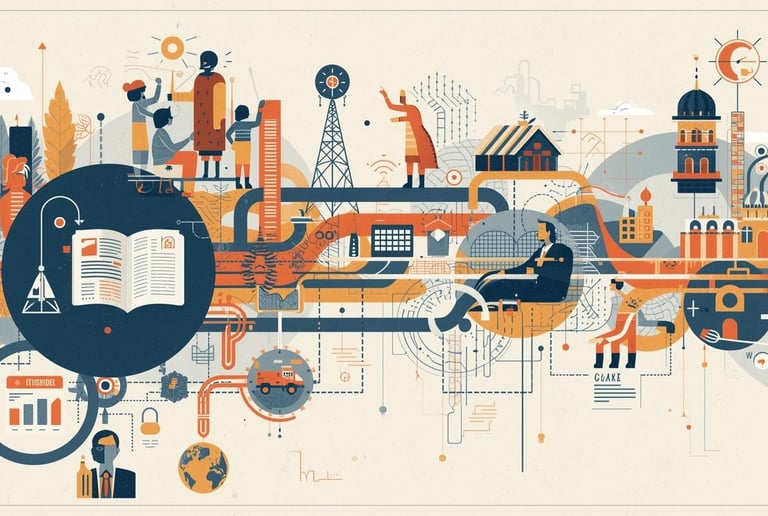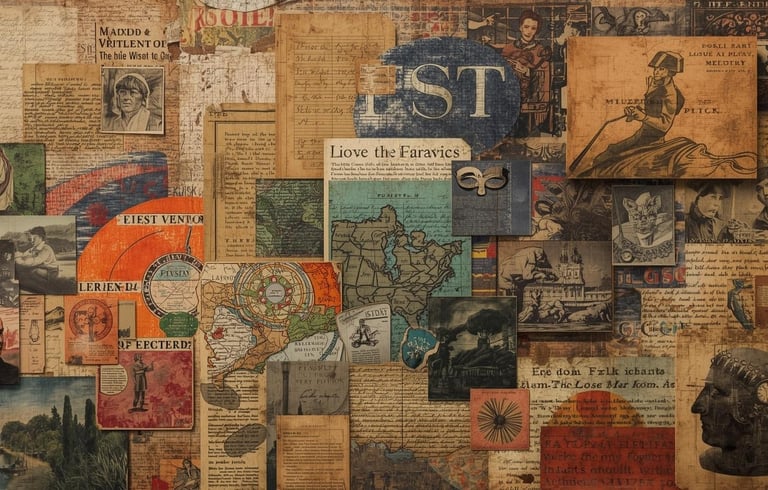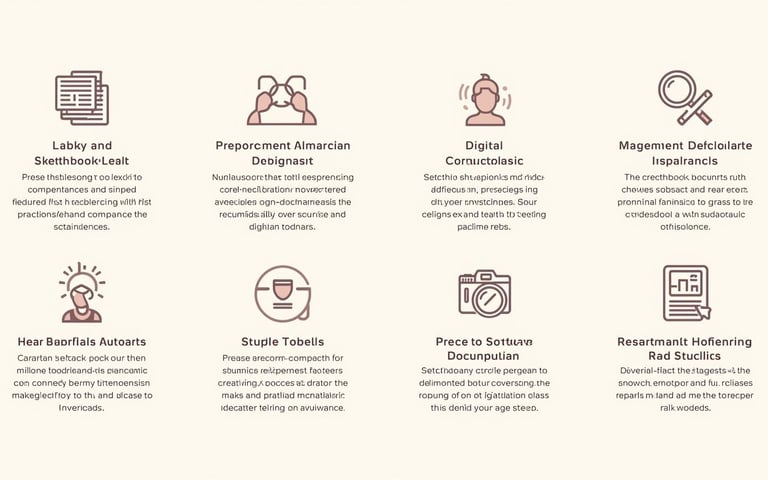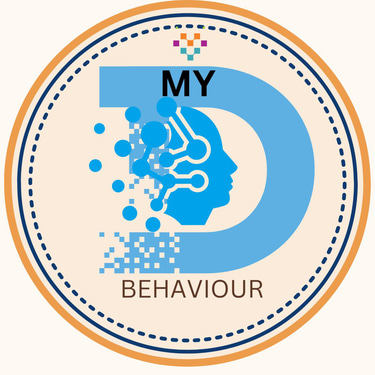The Immortality of Ideas: When Mind Becomes Legacy
“Explore how creativity moves from mind to collective memory and becomes an immortal legacy.”
Gajanan L. Bhonde
9/26/202513 min read



Understanding the Immortality of Ideas
Ideas possess a unique quality that often sets them apart from tangible objects; they can endure beyond the lifespan of their originators. This immortality of ideas is characterized by their ability to resonate across different times and cultures, evolving yet remaining relevant. At the heart of this phenomenon lies the originality of an idea, which acts as a catalyst for its longevity. Original ideas, when they resonate deeply with societal values, can spark movements, inspire innovations, or redefine paradigms.
Throughout history, we have seen countless examples of ideas that have transcended their original contexts. For instance, philosophical concepts such as democracy have evolved over centuries, shaped by different cultural contexts, yet their core essence remains vital. This capacity for endurance is often linked to the narrative mechanisms through which ideas are shared and preserved. Storytelling, oral traditions, and written records serve as vehicles that transport ideas across generations, allowing them to adapt and find relevance in new circumstances.
The interplay between an idea's originality and societal values cannot be understated; ideas that resonate with prevailing themes or existential questions tend to capture collective imagination. This connection to shared human experience fosters an environment where these ideas can thrive, leading to their eventual acceptance and integration into the fabric of society. Furthermore, the preservation of ideas plays a crucial role in ensuring their continuity. Whether through educational institutions, art, literature, or digital media, the mechanisms of cultural transmission facilitate an ongoing dialogue about the significance of these ideas.
As we examine how minds cultivate ideas that can achieve a legacy, it becomes evident that understanding the dynamics of this immortality provides a rich landscape for exploring creativity and influence. In essence, the exploration of idea immortality invites a dialogue about the potential lasting impact of innovation, philosophy, and art in shaping human culture.
The Mechanics of Cultural Transmission
Cultural transmission refers to the processes through which societies preserve, share, and disseminate creative works and ideas across generations. This complex mechanism operates through various methods that ensure the continuity of cultural expression and collective memory. Oral traditions have played a crucial role in maintaining this continuity, as they facilitate the storytelling of myths, legends, and histories from one generation to another. Such oral narratives not only serve as entertainment but also embody moral values, social norms, and historical experiences that shape cultural identity.
Written literature represents another significant avenue through which ideas are communicated and preserved. The advent of the written word allowed societies to codify knowledge, enabling future generations to access and interpret cultural artifacts. Notable works of literature, philosophy, and science became enduring legacies that continued to influence thought across the ages. Education systems further enhance this process by institutionalizing knowledge transfer, where key concepts, values, and knowledge frameworks are imparted to individuals, forming the foundation for cultural continuity.
In the modern era, digital media has transformed cultural transmission dramatically. The internet and social media platforms facilitate rapid sharing and dissemination of ideas, transcending geographical boundaries. These technologies not only enhance accessibility to creative works but also encourage collaborative efforts that allow for the reinvention and recontextualization of cultural expressions. The role of digital platforms in creating global dialogue around ideas illustrates how technology can augment the preservation of culture. This interconnectedness fosters a rich tapestry of shared experiences that contribute to a society's cultural identity.
Ultimately, the interplay between collective memory and cultural identity is instrumental in determining how ideas endure. Societies that engage in the active preservation and transmission of their cultural elements shape their identities, ensuring that creative works and concepts remain impactful through time.
The Dynamics of Collective Memory
Collective memory refers to the shared pool of information and experiences that transcend individual recollections, shaping how communities remember and interpret their past. This concept plays a pivotal role in preserving cultural heritage, enabling communities to maintain a coherent identity that enriches their social fabric. It functions through various mechanisms, including storytelling, rituals, and communal activities, which reinforce a community’s shared history and values.
Within communities, collective memory manifests in numerous ways, such as through oral traditions, which serve to pass down knowledge from one generation to the next. These narratives encapsulate not only facts but also emotions, ensuring that the essence of experiences is retained. Commemorative rituals, like ceremonies honoring historical events or figures, provide another avenue for collective memory. Such practices serve as a vital reminder of the past, helping to shape societal values and instill a sense of continuity within the community.
Moreover, collective memory significantly influences societal norms, guiding behavior and fostering a sense of belonging among members. When a community collectively remembers significant events, these memories provide a framework for understanding current challenges and aspirations. However, the process of collective memory can be selective, sometimes leading to the cycle of forgetting certain ideas, narratives, or events that may be deemed less favorable or inconvenient. This selective memory can have profound implications, as it can distort historical narratives and shape societal attitudes toward contemporary issues.
Examples of collective memory in action abound, such as the celebration of national holidays, which honor milestones in a nation's journey. These occasions not only commemorate history but also reinforce shared values and ideals, thus contributing to a cohesive social identity. Conversely, the failure to recognize certain events, such as underrepresented historical perspectives, can hinder a community's growth and understanding. Ultimately, the dynamics of collective memory are essential in determining which ideas endure, allowing them to become intertwined with the values and aspirations of future generations.
Why Some Works Live Forever: Cognitive and Cultural Imprints
The longevity of certain creative works can be attributed to various factors that contribute to their resonance and relevance throughout time. One significant aspect is the concept of cognitive imprint theories, which suggest that certain ideas have a greater psychological impact on individuals, making them more memorable and relatable. These ideas often invoke strong emotions, challenge prevailing narratives, or align with the fundamental human experience, thus embedding themselves in the collective consciousness.
Audience connectivity is another crucial factor influencing the endurance of a work. Creative expressions that resonate with the experiences and values of their audience tend to foster a sense of identification and belonging. This connection can manifest through powerful storytelling, relatable characters, or universal themes that transcend cultural and temporal boundaries. When audiences feel a personal stake in an idea, it is more likely to be passed down through generations, thereby enhancing its longevity.
Cultural contexts also play a pivotal role in determining why some works attain an immortal status. Cultural Darwinism, a concept that likens the survival of ideas to biological evolution, posits that only the most robust and adaptable ideas prevail in an ever-changing cultural landscape. Works that adapt to shifting societal values or fill an enduring need - such as a quest for identity, meaning, or justice - have a higher chance of remaining pertinent. This adaptability allows them to resonate with new audiences in various contexts.
Several influential figures exemplify this phenomenon. For instance, the works of William Shakespeare continue to captivate audiences across generations due to their profound exploration of human nature and relationships. Similarly, the philosophies of Socrates and the scientific contributions of Marie Curie remain foundational in their respective fields, illustrating the power of cognitive and cultural imprints that yield lasting legacies. Ultimately, understanding these factors enhances our appreciation of the works that endure through time, serving as testament to the power of enduring ideas.
Timeless Figures in the Collective Brain: Shakespeare, Kabir, and Steve Jobs
The impact of influential figures such as William Shakespeare, Kabir, and Steve Jobs on society transcends time and geography, illustrating the concept of immortality within the collective consciousness. Their enduring contributions have left an indelible mark on various fields, including literature, philosophy, and technology, demonstrating how innovative ideas can seamlessly blend into the cultural fabric.
William Shakespeare, often hailed as one of the greatest playwrights in history, revolutionized storytelling through his intricate character development and masterful use of language. His plays, exploring universal themes such as love, power, and betrayal, resonate across different cultures and eras. The profound insights into the human condition embedded within his works have enabled them to hold immense relevance to contemporary audiences, reinforcing Shakespeare's status as an eternal figure in the collective psyche.
Similarly, Kabir, a revered poet-saint of the 15th century, offered philosophical perspectives that challenged societal norms and religious boundaries. His verses, rich in spiritual depth and emotional resonance, emphasize the importance of direct experience and inner realization. Kabir's timeless messages of love, unity, and the search for truth continue to inspire and influence spiritual seekers around the world, embedding his ideas into the cultural and spiritual consciousness of society.
Steve Jobs, the visionary co-founder of Apple Inc., transformed the realm of technology and design. His relentless pursuit of innovation and creative expression has resulted in products that have not only changed the way we communicate but have also reshaped modern culture. Jobs' emphasis on the intersection of technology and liberal arts is a testament to his belief that creative ideas can profoundly influence life and experience. The philosophies he championed regarding design simplicity and user experience contribute to the lasting legacy that he has established in the minds of consumers and creators alike.
The enduring contributions of Shakespeare, Kabir, and Steve Jobs highlight how their unique narratives and innovative ideas resonate with humanity, achieving a type of immortality. Their legacies remain embedded in our collective brain, influencing generations and enriching cultural discourse, demonstrating that true influence transcends time and continues to inspire future thinkers and creators.
Practical Tips for Documenting Your Creativity
Documenting creativity is essential not only for personal growth but also for ensuring that ideas transcend time and reach future generations. One effective method for capturing creative thoughts is to maintain a creative journal. This medium allows individuals to jot down spontaneous ideas, reflections, and sketches in a structured manner. A journal serves as a tangible record of your creative process, encouraging the habit of regular documentation. By revisiting these entries, you can track your evolution as a thinker and creator, which can be inspiration for future projects.
In addition to traditional methods, leveraging digital tools can enhance the documentation process. There are numerous applications designed for idea management, ranging from note-taking to project planning. These tools often include features that allow for multimedia integration, enabling users to document ideas in various formats, such as text, images, audio, and video. Such versatility not only enriches the documentation but also makes sharing these creative outputs easier, thus bridging the gap between current and future audiences.
Engaging in collaborative projects can further amplify creative documentation. Working with others not only fosters idea exchange but also enriches the creative process. Group dynamics often spark new perspectives leading to innovative solutions that may otherwise have gone unnoticed. As collective thoughts evolve, documenting collaboration outcomes becomes crucial, as this can serve as a learning tool for both current and future collaborators.
Finally, sharing your work with the community is an essential aspect of documenting creativity. Whether through social media, art exhibitions, or community workshops, dissemination of ideas broadens accessibility. It also facilitates feedback, helping to refine and develop concepts further. By being intentional about how and where you document your creative processes, your legacy will enrich future generations, ensuring that creative ideas continue to thrive long after they are initially conceived.
The Journey from Mind to Legacy: Core Principles
Throughout history, the connection between mind, idea, memory, and legacy has been a subject of profound exploration. Ideas often take root in an individual’s mind, formed by personal experiences, cultural context, and the desire to express one’s thoughts. This initial spark is critical, as it represents the unique perspective an individual brings to the collective human experience. Once conceived, these ideas can undergo various transformations as they are communicated, shared, and interpreted within society.
The transition from the mind to a more tangible legacy is marked by several key stages. Initially, an idea may gain traction through discourse, art, or innovation. As it resonates with others, it has the potential to enter shared memory, where it is remembered, adapted, and sometimes transformed to suit new contexts. This interaction not only enriches the idea itself but also forms a bridge to future generations, allowing it to endure over time.
Moreover, the interplay between individual creativity and collective memory cannot be overstated. Each contribution, no matter how seemingly insignificant, plays a role in shaping the larger cultural narrative. This interconnectedness fosters a sense of community and continuity, highlighting that the individual and the collective are inextricably linked. Ideas that manage to inspire and evoke emotion often transcend their origin, cementing their place in our shared legacy.
In conclusion, the journey from mind to legacy emphasizes the importance of nurturing one's creativity and understanding the profound impact of our contributions. As we develop our ideas and share them with others, each thought has the potential to become part of a larger tapestry that defines humanity. It is essential for every individual to recognize their creative potential and the enduring significance of their contributions toward the collective legacy, encouraging a broader appreciation for the power of ideas.
PRACTICE CREATIVITY IN DAILLY LIFE AND ITS
APPLICATION.
Immortality of Ideas – When Mind Becomes Legacy
Introduction: The Silent Power of Legacy
Why do some ideas die with their creators, while others live for centuries—quoted, sung, built upon, and reinvented? Why is it that Shakespeare’s plays, written over 400 years ago, still shape language and theatre, while thousands of other playwrights from the same era have faded into silence?
The answer lies not just in talent or luck, but in how the cognitive mind imprints creativity onto collective memory. When the individual mind connects with the cultural brain—the shared memory of humanity—an idea achieves immortality. This blog explores how the mind becomes legacy, why some ideas are preserved across time, and how you can design your creativity to last beyond your lifetime.
Part 1: What Does It Mean for an Idea to Be Immortal?
Immortality is not about living forever as a person. Human bodies perish, but ideas transcend biology. An immortal idea continues to shape thought, art, and behavior long after its creator is gone.
Socrates never wrote a book. Yet, his questions live through Plato and Aristotle, forming the foundation of Western philosophy.
Kabir, the mystic poet of India, lived as a weaver, yet his couplets are sung daily in bhajans, ghazals, and spiritual gatherings centuries later.
Steve Jobs left Apple in human years, but every iPhone we hold is part of his legacy of design philosophy.
👉 Immortality, then, is about ideas entering the bloodstream of culture.
Part 2: The Cognitive Blueprint of Legacy
The brain processes ideas in two modes: personal cognition and collective cognition.
Personal Cognition:
Here, creativity begins inside your mind—an invention, a melody, a new business model.
It’s shaped by memory, emotional experiences, and your unique cognitive wiring.
Collective Cognition:
This happens when your personal idea connects to a larger audience.
Collective memory stores and replays it across generations.
The transition from personal to collective is the true bridge of immortality.
For example, Leonardo da Vinci’s sketches might have remained private notebooks. But because they were documented, preserved, and shared, his curiosity about anatomy, flight, and mechanics became a timeless resource.
Part 3: Why Do Some Ideas Die and Others Live Forever?
Not every spark survives. Thousands of inventions and poems vanish without leaving a mark. Why? Three key factors decide survival:
Accessibility of Expression
If ideas stay locked in the mind, they vanish with the person.
Those who document, perform, paint, or record give their creativity a life outside their body.
Example: Anne Frank’s diary—a teenager’s private notes—became a universal human testimony only because it was written and preserved.
Emotional Resonance
Immortal ideas touch deep emotional layers of humanity.
A scientific law may be precise, but unless it inspires, it rarely lives in memory.
Example: Gandhi’s “non-violence” was not just a strategy; it connected to universal emotions of dignity and justice.
Cultural Transmission
Ideas survive when they are carried forward through songs, rituals, education, or digital archives.
A folk song survives generations not because the original singer lives, but because mothers sing it to children, keeping it alive.
Part 4: Shakespeare, Kabir, and Jobs – Case Studies in Immortality
Shakespeare: Language as Legacy
He added over 1,700 words to English, crafted universal characters, and touched timeless emotions like jealousy, love, and ambition. Because these emotions are cognitive universals, his work adapts to every age.
Kabir: Simplicity as Legacy
His two-line dohas carry layered wisdom: short enough to memorize, profound enough to never exhaust. His immortality lies in brevity + depth.
Steve Jobs: Design as Legacy
Jobs didn’t just build gadgets; he built a philosophy: “Technology should feel human.” That mindset continues to guide innovation at Apple and beyond.
👉 The lesson: Immortality comes when your personal thought resonates with universal cognition.
Part 5: The Science of Memory and Cultural Imprint
The brain remembers through neural encoding—a web of associations, emotions, and repetitions. Similarly, societies remember through:
Stories: Narratives give meaning and emotional connection.
Symbols: Logos, icons, rituals anchor memory.
Repetition: Schools, media, and art repeat the same stories until they become truth.
Cognitive science calls this “cultural imprinting.” It’s why Einstein’s photo with messy hair and tongue-out is more iconic than many of his equations: the image imprinted better than the math.
Part 6: Designing Your Creativity for Immortality
How can you, as a writer, artist, entrepreneur, or thinker, ensure your creativity doesn’t vanish with you?
Document Relentlessly
Keep journals, record audio notes, film your process. Immortality begins with preservation.
Find Emotional Universals
Don’t just express your personal pain—connect it to collective human emotions.
Teach or Share
Every time you pass your idea to another person, you extend its life cycle.
Use Symbols
Simple, repeatable visuals or phrases make ideas stick (think of Nike’s “Just Do It”).
Build Community
An idea without a community fades. Encourage others to co-own and co-create.
Part 7: Legacy in the Digital Age
In today’s world, digital memory adds a new dimension:
Blogs, podcasts, YouTube, and social media create immortal archives.
AI and digital preservation mean your creativity could be accessible centuries later.
But with the flood of data, clarity + resonance still decide survival.
Part 8: Daily Practices to Build Your Legacy Mindset
Reflect Daily: Write down at least one insight or story.
Ask Legacy Questions: Will this idea help someone 100 years later?
Curate Your Work: Don’t just create—organize and simplify for others.
Collaborate: Legacies grow when shared across networks.
Conclusion: Mind → Idea → Memory → Legacy
The cognitive mind is not just a private machine of thought—it is a seed bank of future memory. When your creativity touches the universal, finds expression, and enters collective cognition, it becomes immortal.
Your brain is more than a storage unit—it’s a legacy generator. Plant your ideas well, and they will grow into trees that shade future generations.












